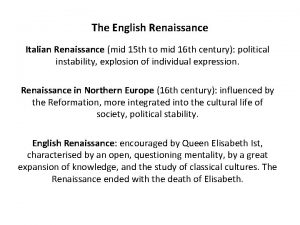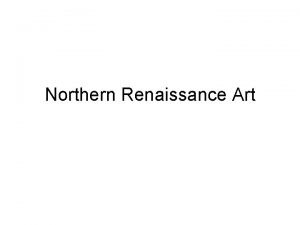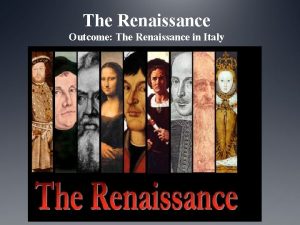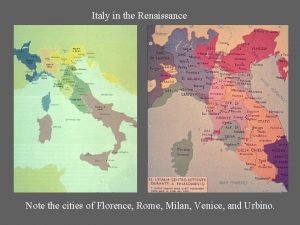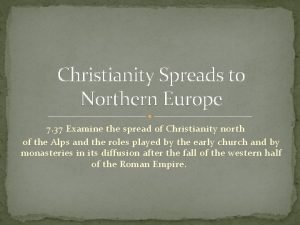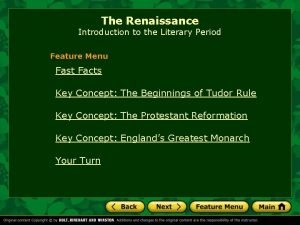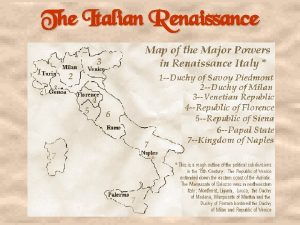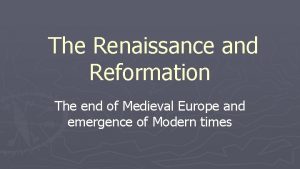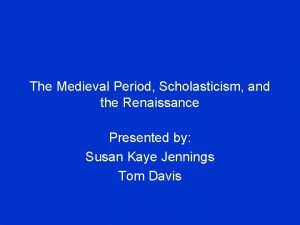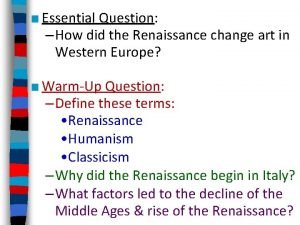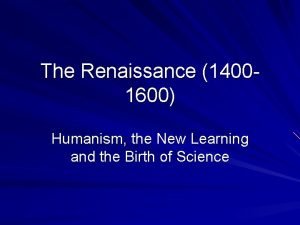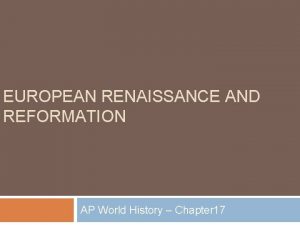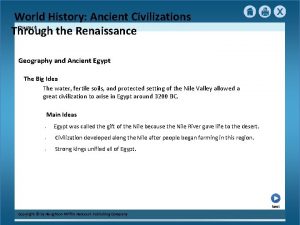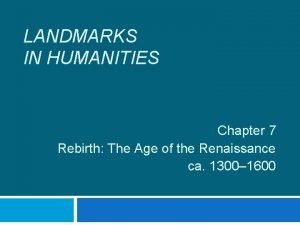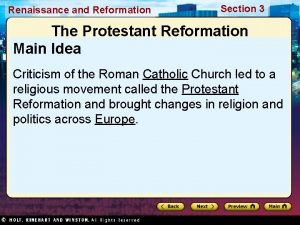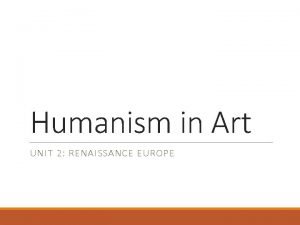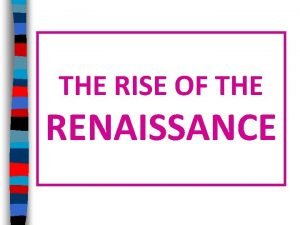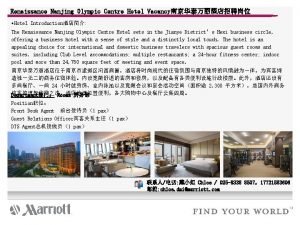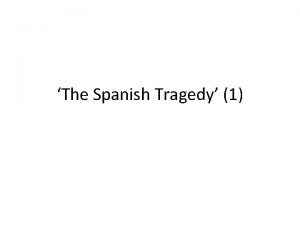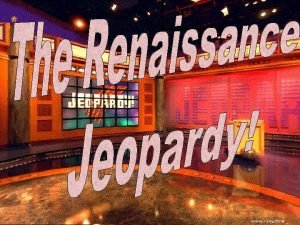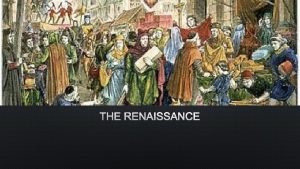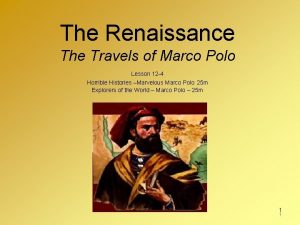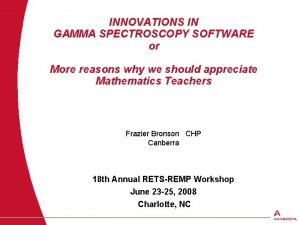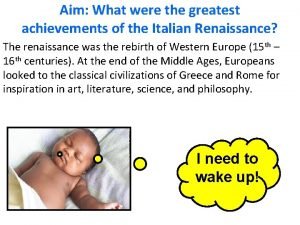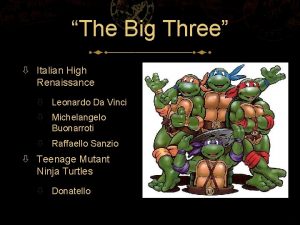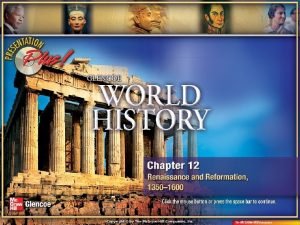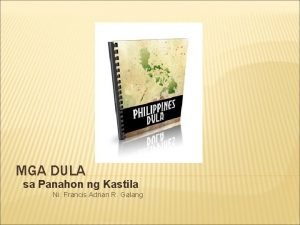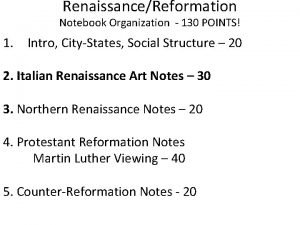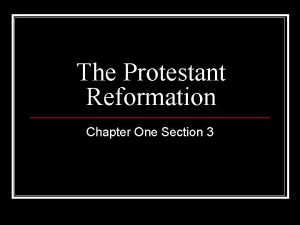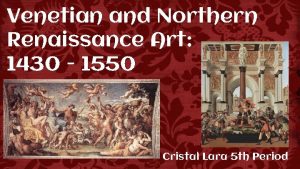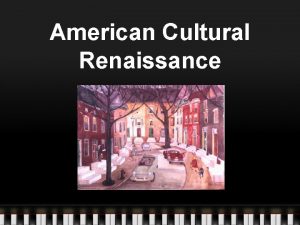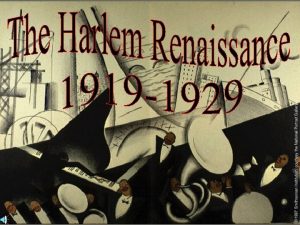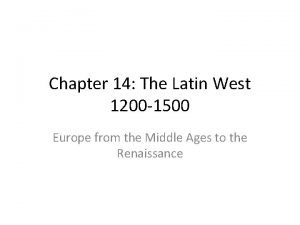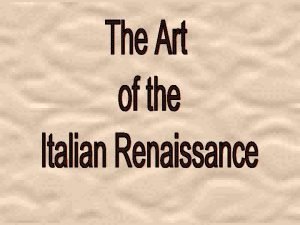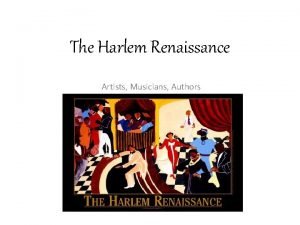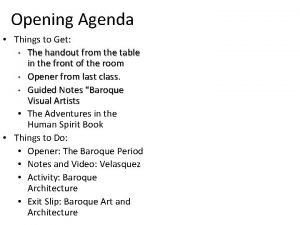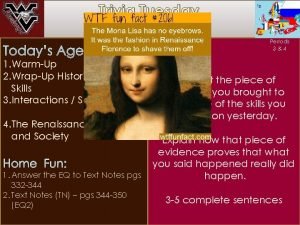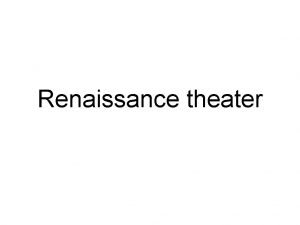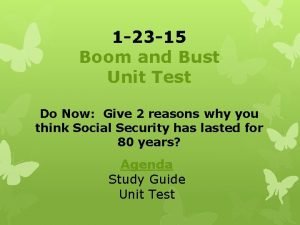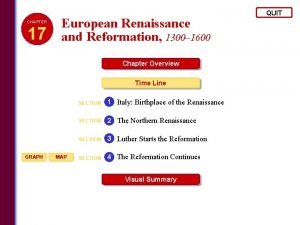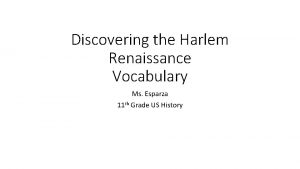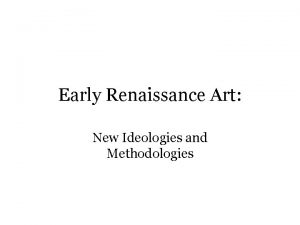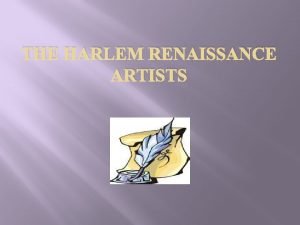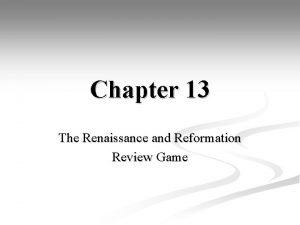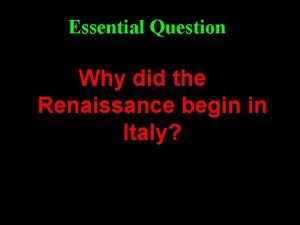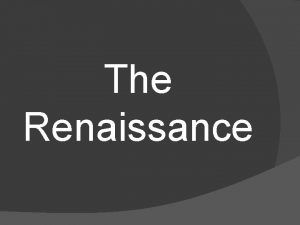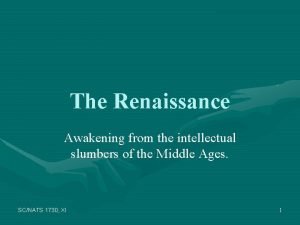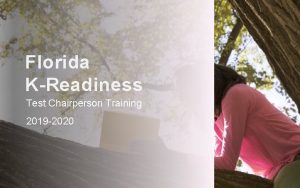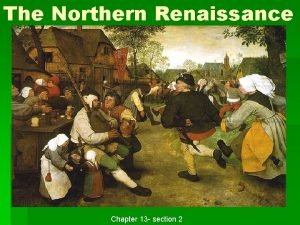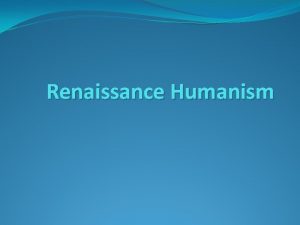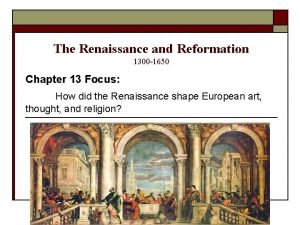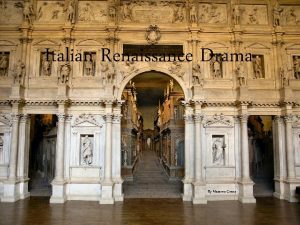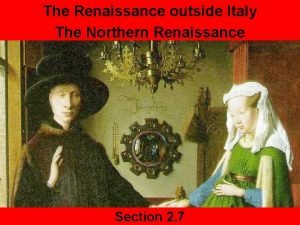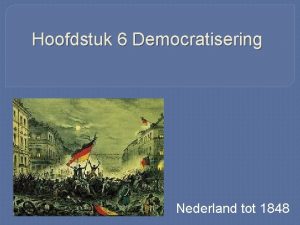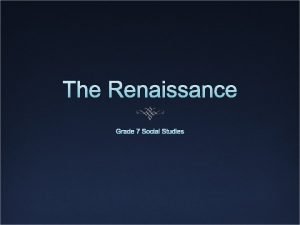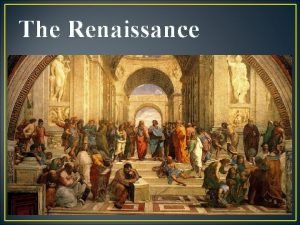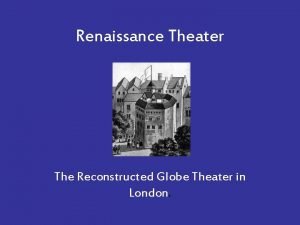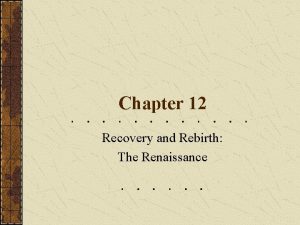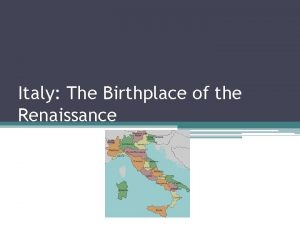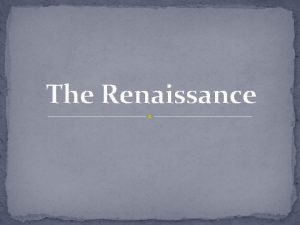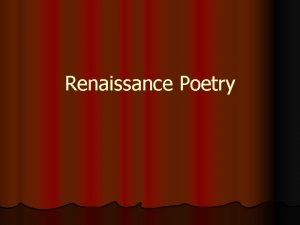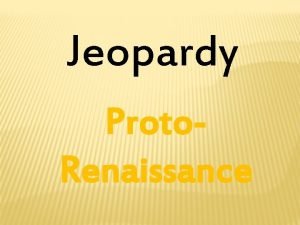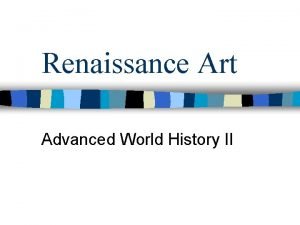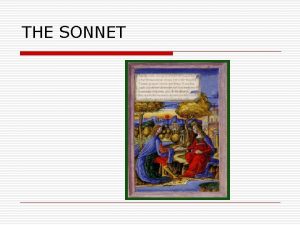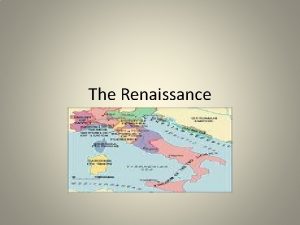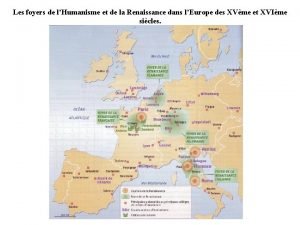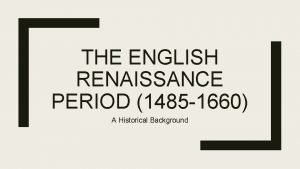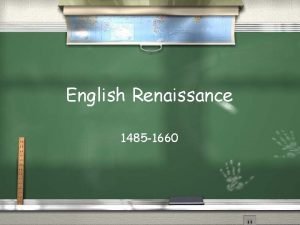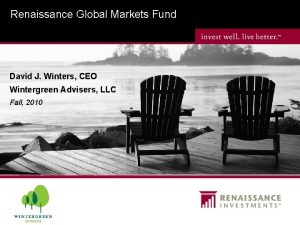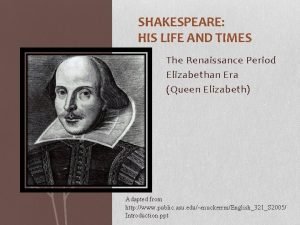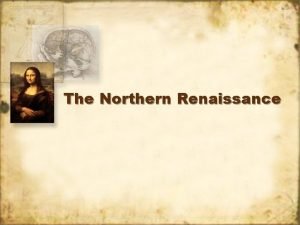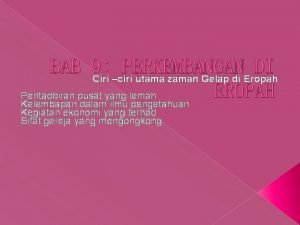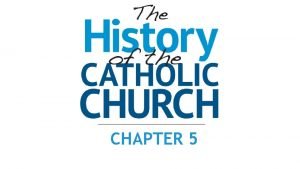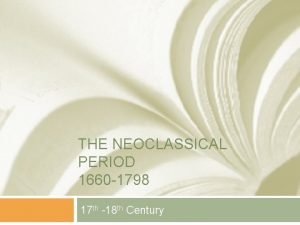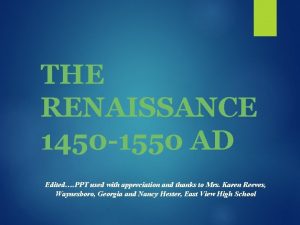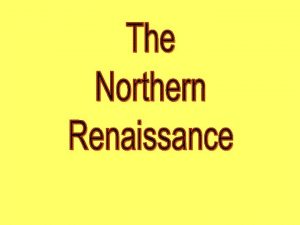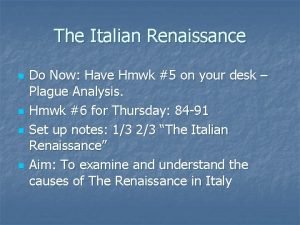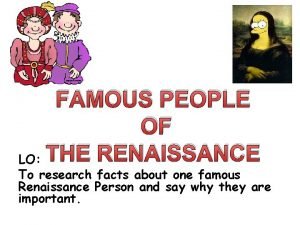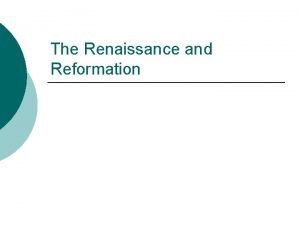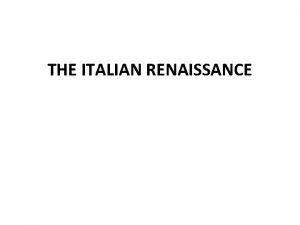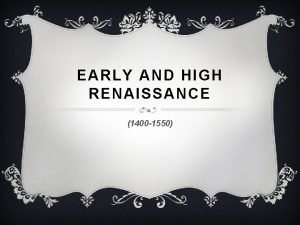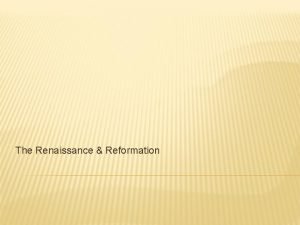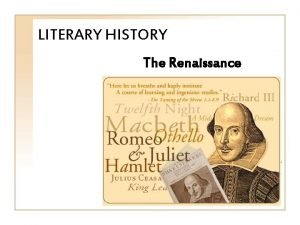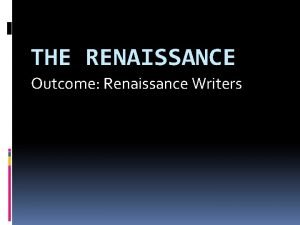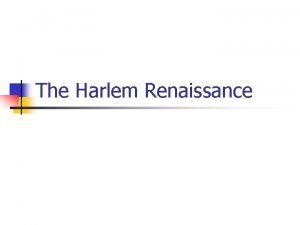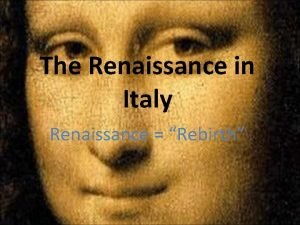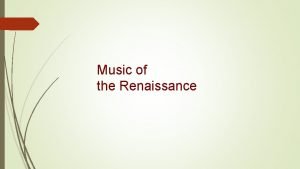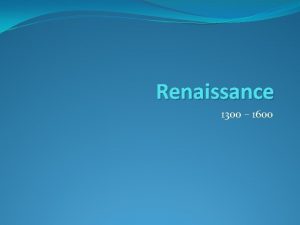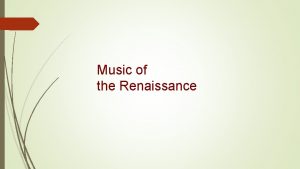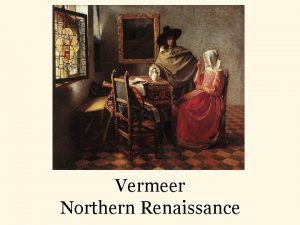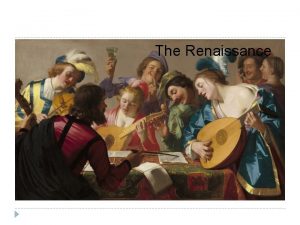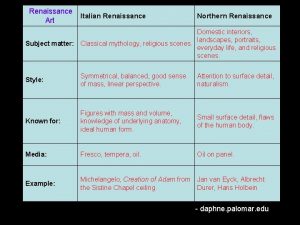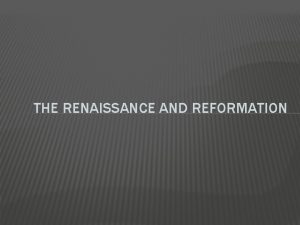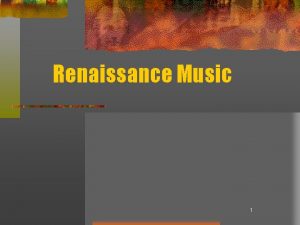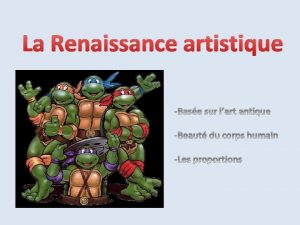The Renaissance 14 th 15 th 16 th
















































































































































- Slides: 144

The Renaissance 14 th 15 th 16 th Centuries in Europe

Definition = Re-Birth ¨ The Renaissance was a time of creativity and change ¨ Rebirth in classical learning – Greeks and Romans ¨ Concentration on living in the present

1 - The Beginning ¨ Renaissance began in Italy – Rome was there – Florence, Venice, Genoa were wealthy citystates ¨ Medici family were patrons of the arts

The Renaissance, centuries th th 14 -16 ¨ “rebirth” of classical culture ¨ Italian artists use perspective ¨ Work with real human anatomy and musculature – Leonardo da Vinci (1452 -1519) ¨ Architecture: domed cathedrals – Imitation of Roman domes

The Renaissance Began in Italy ¨ Renewed interest in Greek & Roman literature and life. ¨ Ruins of Roman empire dotted the Italian countryside. ¨ Crusades and trade with the Middle East Brought Italians into contact with Byzantine civilization. ¨ Increased trade brought wealth and wealth brought the leisure time to pursue other interests.


Merchants ¨ Merchants dominated politics and society. ¨ Catholic Church weakened ¨ Merchants emerged as the most powerful.

Italian City States ¨ Milan, Venice, & Florence all played critical roles in Italian politics ¨ City-states profited from trade that expanded during the Middle Ages ¨ Italians traded by ship ¨ Traded with Byzantine empire & Islamic civilizations in East

Milan ¨ Located in Northern Italy ¨ One of the richest cities in Italy


Venice ¨ Link Between Asia & western Europe ¨ City drew traders from all over the world

Florence ¨ Dominated the region of Tuscany ¨ 1434, Cosimo de Medici took control of the city/ wealthy Medici family controlled government from behind the scenes

“I smell cheese, I think”

Golden Age of the Arts ¨ Many portraits painted ¨ Sculpture was realistic ¨ Use of perspective in painting

The Great Artists ¨ Leonardo da Vinci – Mona Lisa – Last Supper – Scientist ¨ Michelangelo – David – Pieta – Sistine Chapel (ceiling) ¨ Raphael – School of Athens – Madonna

Renaissance

Michelangelo

Renaissance Leonardo

Raphael

Botticelli – Birth of Venus

Pieter Bruegel

Niccolo Machiavelli ¨ Wrote The Prince ¨ Told rulers to use any means possible to achieve goals ¨ “The end justifies the means”

Durer

Renaissance van Eyck


Realism & Expression Expulsion from the Garden Masaccio 1427 First nudes since classical times.

Perspective The Trinity Perspective! Perspective! Masaccio 1427 Perspective! First use of linear perspective! What you are, I once was; what I am, you will become.

Classicism Greco-Roman influence. Secularism. Humanism. Individualism free standing figures. Symmetry/Balance The “Classical Pose” Medici “Venus” (1 c)

Emphasis on Individualism Piero della Francesca, 1465 -1466.

Geometrical Arrangement of Figures The Dreyfus Madonna with the Pomegranate Leonardo da Vinci 1469 The figure as architecture!

Light & Shadowing/Softening Edges Sfumato Chiaroscuro


Renaissance Florentine lion: symbol of St. Mark 1252 – first gold florins minted The Wool Factory. Mirabello Cavalori, 1570

Lorenzo the Magnificent 1478 - 1521 Cosimo de Medici 1517 - 1574

Florence Under the Medici Chapel The Medici Palace

Dome Comparisons Il Duomo capital (Florence) St. Peter’s (Rome) St. Paul’s (London) US (Washington)

Humanism ¨ Started to think about secular world and less about religious world

The Humanists ¨ Humanities: literature, history, moral philosophy ¨ Renaissance humanists deeply devoted to Christianity – Desiderius Erasmus (1466 -1536) publishes critical Greek-Latin edition of New Testament ¨ Also devoted to rediscovering classical Latin texts, often ignored in monastic libraries

Humanist Moral Thought ¨ Rejection of monastic lifestyle in favor of morally virtuous life while engaged in the world – Marriage, business ¨ Reconciliation of Christianity with rapidly changing European society and economy

The Renaissance “Man” • Broad knowledge about many things in different fields. • Deep knowledge/skill in one area. • The Greek ideal of the “well-rounded man” was at the heart of Renaissance education.

Self-Portrait -- da Vinci, 1512 Artist Sculptor Architect Scientist Engineer Inventor 1452 - 1519

Leonardo, the Artist The Virgin of the Rocks Leonardo da Vinci 1483 -1486

Leonardo, the Artist: From his. Notebooks of over 5000 pages (1508 -1519)

Mona Lisa – da Vinci, 1503 -4

A Macaroni Mona

A Picasso Mona

An Andy Warhol Mona

B. Mona Lisa

The Last Supper - da Vinci, 1498 & Geometry


David Michelangelo Buonarotti 1504 Marble

15 c What a difference a century makes! 16 c

The Popes as Patrons of the Arts The Pieta Michelangelo Buonarroti 1499 marble

The Sistine Chapel Michelangelo Buonarroti 1508 - 1512

The Sistine Chapel’s Ceiling Michelangelo Buonarroti 1508 - 1512

The Sistine Chapel Details The Creation of the Heavens

The Sistine Chapel Details Creation of Man

The Sistine Chapel Details The Fall from Grace

The Sistine Chapel Details The Last Judgment


Characteristics of Northern Renaissance Art ¨ The continuation of late medieval attention to details. ¨ Tendency toward realism & naturalism [less emphasis on the “classical ideal”]. ¨ Interest in landscapes. ¨ More emphasis on middle-class and peasant life. ¨ Details of domestic interiors.


Jan van Eyck (1395 – 1441) ¨ More courtly and aristocratic work. – Court painter to the Duke of Burgundy, Philip the Good. ¨ The Virgin and Chancellor Rolin, 1435.

Van Eyck -Adoration of the Lamb, Ghent Altarpiece, 1432

Van Eyck: The Crucifixion & The Last Judgment 1420 -1425

Giovanni Arnolfini and His Wife (Wedding Portrait) Jan Van Eyck 1434

van der Weyden’s Deposition (details)

Quentin Massys (1465 -1530) ¨ Influenced by da Vinci. ¨ The Ugly Dutchess, 1525 -1530

Massys’ The Moneylender & His Wife, 1514




Albrecht Dürer (1471 -1528) ¨ The greatest of German artists. ¨ A scholar as well as an artist. ¨ His patron was the Emperor Maximilian I. ¨ Also a scientist – Wrote books on geometry, fortifications, and human proportions. ¨ Self-conscious individualism of the Renaissance is seen in his portraits. ¨ Self-Portrait at 26, 1498.

Dürer – Self-Portrait in Fur-Collared Robe, 1500

Dürer The Last Supper woodcut, 1510

Durer – The Triumphal Arch, 15151517

The Triumphal Arch, details


Hans Holbein, the Younger (1497 -1543) ¨ One of the great German artists who did most of his work in England. ¨ Henry VIII was his patron from 1536. ¨ Great portraitist noted for: – Objectivity & detachment. – Doesn’t conceal the weaknesses of his subjects.

Artist to the Tudors Henry VIII (left), 1540 and the future Edward VI (above), 1543.

Holbein’s, The Ambassadors, 1533 A Skull

The English Were More Interested in Architecture than Painting Hardwick Hall, designed by Robert Smythson in the 1590 s, for the Duchess of Shrewsbury [more medieval in style].

Burghley House for William Cecil The largest & grandest house of the early Elizabethan era.


Pieter Bruegel the Elder (1525 -1569) ¨ One of the greatest artistic geniuses of his age. ¨ A master of landscapes; not a portraitist. – People in his works often have round, blank, heavy faces. – They are expressionless, mindless, and sometimes malicious. – They are types, rather than individuals. – Their purpose is to convey a message.

Bruegel’s, Tower of Babel, 1563

Bruegel’s, Mad Meg, 1562

Bruegel’s, The Beggars, 1568

Bruegel’s, Parable of the Blind Leading the Blind, 1568

Bruegel’s, Niederlandisch Proverbs, 1559

Bruegel’s, The Triumph of Death, 1562

Bruegel’s, Hunters in the Snow, 1565

Bruegel’s, Winter Scene, 1565

Bruegel’s, The Harvesters, 1565


El Greco Christ in Agony on the Cross 1600 s

El Greco Portrait of a Cardinal 1600

El Greco’s, The Burial of Count Orgaz, 15861588

El Greco’s, The Burial of Count Orgaz, 15861588 (details)

El Greco’s, The Burial of Count Orgaz, 1578 -1580

El Greco The View of Toledo 15971599

Conclusions ¨ The artistic production of Northern Europe in the 16 c was vast, rich, and complex. ¨ The Northern Renaissance ended with a Mannerist phase, which lasted a generation longer in the North than it did in Italy, where it was outmoded by 1600.

Authors of the Renaissance ¨ William Shakespeare – 37 plays including Romeo and Juliet ¨ Miguel de Cervantes – Spanish author of Don Quixote, made fun of chivalry

Renaissance Literature ¨ Some writers wrote in vernacular language(language spoken in their region) instead of Latin ¨ Italian author Dante & Chaucer helped make vernacular literature more popular

Johann Gutenberg ¨ Developed printing press ¨ Printed several Bibles ¨ Books now cheaper ¨ Spread of information ¨ Increased Literacy

Genius Writers of the Northern Renaissance ¨ William Shakespeare – England. Playwright between 1590 -1613. Wrote about the actual human condition of his time. ¨ Cervates – Spain. Novelist. Wrote Don Quixote.

Dante’s Divine Comedy

B. Dante ¨ Writes The Divine Comedy. ¨ Full of political events and human personalities. ¨ Religious ideas of the Middle Ages with the worldly concerns of the Renaissance. ¨ Written in the vernacular (native language)



Dante, Divine Comedy ¨ Dante = Divine Comedy ¨ Story of the soul’s journey through salvation ¨ Divided into 3 realms = Hell, Purgatory, & Heaven ¨ Dante is led on an imaginary journey through these 3 realms until he reaches paradise

Chaucer, Canterbury Tales ¨ Used English vernacular ¨ Canterbury Tales, most famous work ¨ Consists of a collection of tales told by a group of 29 pilgrims journeying to the tomb of St. Thomas a Becket at Canterbury ¨ Format gave Chaucer the opportunity to portray English society from the high to low class of people

Niccolo Machiavelli ¨ Wrote the Prince ¨ Expresses the Italians love with political power ¨ Central theme of the book Prince was how to acquire & obtain political power ¨ Machiavelli rejected the Christian principles of leadership/ the understanding of human nature was most important ¨ Was one of the first to abandon morality as the basis for analyzing political activity

Renaissance in China The Ming Dynasty

Recovery in China: The Ming Dynasty ¨ Yuan dynasty collapses 1368, Mongols depart ¨ Impoverished orphan raised by Buddhist monks, works through military ranks, becomes Emperor Hongwu ¨ Proclaims new Ming (“Brilliant”) dynasty, 1368 -1644

Ming Centralization ¨ Reestablishment of Confucian educational system ¨ Execution of minister suspected of treason, begins tradition of direct rule by Emperor ¨ Reliance on emissaries called Mandarins ¨ Heavy reliance on eunuchs – Sterile, could not build hereditary power base ¨ Centralized structure lasts through Qing dynasty to 1911

Ming Porcelain: China’s finest china


Ming Ceramics with Arabic Script?

Naval Advances: Early 1400 s ¨ Ming Navigation: Sextant and Star Charts ¨ Exploration: 1400 Visit Persian Gulf – Return with souvenirs – Some knowledge of outside world ¨ Colonization? – Why don’t we speak Chinese?

The Protestant Reformation ¨ Many abuses in Church – Bishops too wealthy – Clergy getting involved in secular affairs – Selling of indulgences (pardon for sins)

Protestant Reformation ¨ Reformation = name given to the religious reform movement that divided the western church into Catholic & Protestant groups

Leading up to the Reformation ¨ Christian humanism = was a school of thought that wanted to reform the Catholic Church ¨ Christian humanists believed in the ability of human beings to reason & improve themselves/they thought if people would read the classics & basic works of Christianity, they would become more pious and then bring change to the Catholic Church ¨ Christian humanists believed that in order to change society, they first had to change individuals

Corruption in the Church ¨ Between 1450 & 1520 a series of popes known as Renaissance popes failed to meet the church’s spiritual needs ¨ Popes too involved in political matters & not enough in religious matters ¨ Church officials were concerned with money & used their church offices to get wealthy and advance their careers

St. Peter’s Basilica

Corruption in the Church ¨ Ordinary priests were ignorant of their duties ¨ People wanted to know how to save their souls & priests were unable to offer advice or instruction ¨ Church leaders were failing to meet their responsibilities & people wanted assurance of salvation ¨ Churches started selling relics as a source of indulgence ¨ Indulgences attached to relics could reduce time in Purgatory by 1443 years ¨ Indulgences were also sold as certificates

Protestant Reformation ¨ Selling indulgences - The Church taught that most Christians after death went to purgatory to suffer a time of punishment for their sins before going to heaven. Indulgences were intended to remit a part of that time. They were granted previous to death by the Church for various good works that came to include monetary offerings. This became very controversial because it appeared that the Church was selling the right to avoid all or part of an individual’s time in purgatory.

Martin Luther ¨ Attacked selling of indulgences ¨ Wrote 95 Theses – list of arguments against Church ¨ Was excommunicated ¨ Beginning of “Protestantism”

Luther’s Teachings ¨ Salvation achieved through “faith alone” ¨ Bible was only source of religious truth ¨ Said no need for Church hierarchy ¨ Translated Bible into German ¨ Simplified Mass ¨ Clergy could marry

Ninety-Five Theses ¨ Luther was not a rebel, just trying to do what was right & was greatly upset with the selling of indulgences ¨ Luther did not want to start a new religion he only wanted the Catholic Church to reform.

John Calvin ¨ Many teachings similar to Luther ¨ Predestination – God has already determined who was going to Heaven

4 – Reformation Ideas Spread ¨ Henry VIII broke from Church over marriage, annulment, divorce ¨ He started Church of England ¨ Catholic vs. Protestants in England ¨ Elizabeth I keeps England Protestant

Break with the Church ¨ By 1520, Luther was calling for a break from the Church/called on German princes to overthrow the papacy in Germany and form a reformed church ¨ Luther attacked the use of sacraments/thought priests were using them to destroy the real meaning of the gospel ¨ Luther only kept 2 sacraments = Baptism & Communion ¨ Luther also called for the clergy to marry/went against Catholic requirement of celibacy

Lutheranism ¨ Salvation by faith alone ¨ Simplified church doctrine and rituals ¨ Services in common language so more people could attend and understand ¨ Bible was translated into German

Calvinist ¨ John Calvin ¨ God had all encompassing power ¨ Directs everything; past, present and future ¨ God determines the fate of every single person ¨ Support came from the Netherlands and Scotland

Anabaptists ¨ Initiated practice of baptism ¨ Only people who were free and informed could make the decision to become Christians ¨ Separation of church and state

The Church of England ¨ Between 1536 and 1540, Henry had monasteries and convents closed. ¨ When Henry died in 1547, his 10 year old son Edward became king. He “ruled” only 5 years. ¨ Henry’s Catholic daughter Mary I came to the throne. Tried to return England to Catholicism. Burned dissenters at the stake. “Bloody Mary”


The Church of England ¨ Between 1536 and 1540, Henry had monasteries and convents closed. ¨ When Henry died in 1547, his 10 year old son Edward became king. He “ruled” only 5 years. ¨ Henry’s Catholic daughter Mary came to the throne. Tried to return England to Catholicism. Burned dissenters at the stake. “Bloody Mary” ¨ When Mary died in 1558, Henry’s Protestant daughter Elizabeth took the throne. She returned England to Protestantism.

Catholic Reformation or Counter-Reformation

Reforms ¨Eliminate Abuses ¨Rebirth of faith among followers ¨Reassess Church Principles ¨Restore authority to Pope ¨Stop spread of Protestantism

Inquisition ¨ Rid Italy of those that denied the existence of the church, especially the Protestants ¨ Restore authority of the Pope ¨ Implemented censorship to stop spread of humanist thinking that led the Italian Renaissance ¨ Published list of banned books

Results of Catholic Reformation ¨ Tried to spread Catholicism and win back lands lost to Protestants ¨ Jesuits were the key missionaries that went out ¨ The Catholics were not successful in completely stopping the spread of Protestantism

Catholic Reformation ¨ The commission blamed the problems on corrupt popes ¨ Final decrees of Council of Trent = reaffirmed traditional Catholic teachings, both faith and good works were declared necessary for salvation, seven sacraments were upheld, Belief in purgatory was strengthened, selling of indulgences was forbidden
 The renaissance outcome renaissance painters/sculptors
The renaissance outcome renaissance painters/sculptors Italian renaissance vs english renaissance
Italian renaissance vs english renaissance Flemish renaissance art characteristics
Flemish renaissance art characteristics The renaissance outcome the renaissance in italy
The renaissance outcome the renaissance in italy The renaissance outcome the renaissance in italy
The renaissance outcome the renaissance in italy Last supper labeled
Last supper labeled Italian renaissance vs northern renaissance venn diagram
Italian renaissance vs northern renaissance venn diagram The renaissance introduction to the renaissance answer key
The renaissance introduction to the renaissance answer key Diễn thế sinh thái là
Diễn thế sinh thái là Vẽ hình chiếu vuông góc của vật thể sau
Vẽ hình chiếu vuông góc của vật thể sau Lp html
Lp html V cc cc
V cc cc 101012 bằng
101012 bằng Lời thề hippocrates
Lời thề hippocrates Khi nào hổ con có thể sống độc lập
Khi nào hổ con có thể sống độc lập Tư thế worm breton
Tư thế worm breton đại từ thay thế
đại từ thay thế Quá trình desamine hóa có thể tạo ra
Quá trình desamine hóa có thể tạo ra Cong thức tính động năng
Cong thức tính động năng Thế nào là mạng điện lắp đặt kiểu nổi
Thế nào là mạng điện lắp đặt kiểu nổi Các loại đột biến cấu trúc nhiễm sắc thể
Các loại đột biến cấu trúc nhiễm sắc thể Thế nào là sự mỏi cơ
Thế nào là sự mỏi cơ Bổ thể
Bổ thể Vẽ hình chiếu đứng bằng cạnh của vật thể
Vẽ hình chiếu đứng bằng cạnh của vật thể Phản ứng thế ankan
Phản ứng thế ankan Kể tên các môn thể thao
Kể tên các môn thể thao Thiếu nhi thế giới liên hoan
Thiếu nhi thế giới liên hoan Khi nào hổ con có thể sống độc lập
Khi nào hổ con có thể sống độc lập Chúa yêu trần thế
Chúa yêu trần thế điện thế nghỉ
điện thế nghỉ Một số thể thơ truyền thống
Một số thể thơ truyền thống Trời xanh đây là của chúng ta thể thơ
Trời xanh đây là của chúng ta thể thơ Bảng số nguyên tố lớn hơn 1000
Bảng số nguyên tố lớn hơn 1000 Tỉ lệ cơ thể trẻ em
Tỉ lệ cơ thể trẻ em Tia chieu sa te
Tia chieu sa te Các châu lục và đại dương trên thế giới
Các châu lục và đại dương trên thế giới Thế nào là hệ số cao nhất
Thế nào là hệ số cao nhất ưu thế lai là gì
ưu thế lai là gì Hệ hô hấp
Hệ hô hấp Tư thế ngồi viết
Tư thế ngồi viết Cái miệng nó xinh thế chỉ nói điều hay thôi
Cái miệng nó xinh thế chỉ nói điều hay thôi Hình ảnh bộ gõ cơ thể búng tay
Hình ảnh bộ gõ cơ thể búng tay đặc điểm cơ thể của người tối cổ
đặc điểm cơ thể của người tối cổ Mật thư tọa độ 5x5
Mật thư tọa độ 5x5 Tư thế ngồi viết
Tư thế ngồi viết Thẻ vin
Thẻ vin Voi kéo gỗ như thế nào
Voi kéo gỗ như thế nào Thể thơ truyền thống
Thể thơ truyền thống Các châu lục và đại dương trên thế giới
Các châu lục và đại dương trên thế giới Từ ngữ thể hiện lòng nhân hậu
Từ ngữ thể hiện lòng nhân hậu Northern renaissance art characteristics
Northern renaissance art characteristics Italian renaissance location
Italian renaissance location Golden ratio renaissance
Golden ratio renaissance Renaissance humanism characteristics
Renaissance humanism characteristics Scholasticism in the renaissance
Scholasticism in the renaissance Renaissance art questions
Renaissance art questions The word renaissance means
The word renaissance means Renaissance and new learning
Renaissance and new learning European renaissance and reformation answer key
European renaissance and reformation answer key World history ancient civilizations through the renaissance
World history ancient civilizations through the renaissance Where was the early renaissance (ca. 1400-1490) centered?
Where was the early renaissance (ca. 1400-1490) centered? Renaissance spread map
Renaissance spread map Medieval and renaissance differences
Medieval and renaissance differences Renaissance essential questions
Renaissance essential questions Topic 4 the renaissance and reformation
Topic 4 the renaissance and reformation Renaissance nanjing olympic centre hotel
Renaissance nanjing olympic centre hotel Renaissance hero characteristics
Renaissance hero characteristics Renaissance vocab
Renaissance vocab Italian renaissance costumes
Italian renaissance costumes French word meaning rebirth
French word meaning rebirth Marco polo renaissance
Marco polo renaissance Gamma spectroscopy software
Gamma spectroscopy software The new england renaissance
The new england renaissance Medieval vs renaissance
Medieval vs renaissance Big three of the high renaissance
Big three of the high renaissance What characterizes the renaissance
What characterizes the renaissance Dula sa panahon ng kastila
Dula sa panahon ng kastila Renaissance and reformation interactive notebook
Renaissance and reformation interactive notebook What is the renaissance a rebirth of
What is the renaissance a rebirth of Give up one’s views or beliefs
Give up one’s views or beliefs Venetian and northern renaissance (1430–1550)
Venetian and northern renaissance (1430–1550) Renaissance folk music
Renaissance folk music Harlem renaissance map
Harlem renaissance map Renaissance europe 1500 map
Renaissance europe 1500 map English georgian floral design
English georgian floral design Humanism emphasized
Humanism emphasized Harlem renaissance
Harlem renaissance Baroque vs renaissance
Baroque vs renaissance Renaissance vs middle ages
Renaissance vs middle ages Komedie renaissance
Komedie renaissance The harlem renaissance: mastery test
The harlem renaissance: mastery test European renaissance and reformation chapter 1 answer key
European renaissance and reformation chapter 1 answer key Harlem renaissance vocabulary
Harlem renaissance vocabulary Characteristics of early renaissance art
Characteristics of early renaissance art Important events in the renaissance
Important events in the renaissance Renaissance man examples
Renaissance man examples Harlem renaissance map
Harlem renaissance map Chapter 13 renaissance and reformation
Chapter 13 renaissance and reformation Where did the renaissance begin
Where did the renaissance begin Renaissance (1537 ad - 1660 ad)
Renaissance (1537 ad - 1660 ad) The renaissance hotel boston
The renaissance hotel boston Renaissance awakening
Renaissance awakening Kreadiness
Kreadiness Chapter 13 section 1 the renaissance in italy
Chapter 13 section 1 the renaissance in italy The term renaissance means
The term renaissance means Renaissance
Renaissance Italian renaissance actors
Italian renaissance actors Characteristics of the northern renaissance
Characteristics of the northern renaissance Koninkrijken der renaissance
Koninkrijken der renaissance Colonial williamsburg period floral design
Colonial williamsburg period floral design Renaissance definition social studies
Renaissance definition social studies What does the word renaissance literally mean
What does the word renaissance literally mean Globe theater renaissance
Globe theater renaissance Italian renaissance timeline
Italian renaissance timeline Where was the birthplace of the renaissance
Where was the birthplace of the renaissance Define humanism renaissance
Define humanism renaissance Where did the renaissance begin
Where did the renaissance begin Renaissance poetry characteristics
Renaissance poetry characteristics Renaissance triple set
Renaissance triple set Proto renaissance art
Proto renaissance art Renaissance history definition
Renaissance history definition Sonnet renaissance
Sonnet renaissance Cradle of the renaissance
Cradle of the renaissance Harlem renaissance webquest
Harlem renaissance webquest Les foyers de l'humanisme
Les foyers de l'humanisme Middle ages
Middle ages The english renaissance period
The english renaissance period The english renaissance 1485 to 1660
The english renaissance 1485 to 1660 Renaissance emerging markets fund
Renaissance emerging markets fund Shakespeare renaissance period
Shakespeare renaissance period Secular music
Secular music Renaissance vs romanticism
Renaissance vs romanticism Dampak langsung reformasi gereja
Dampak langsung reformasi gereja Italian and northern renaissance similarities
Italian and northern renaissance similarities Ciri-ciri zaman renaissance
Ciri-ciri zaman renaissance Similarities between middle ages and renaissance
Similarities between middle ages and renaissance Renaissance vs neoclassical
Renaissance vs neoclassical Castiligione
Castiligione Renaissance art ppt
Renaissance art ppt Renaissance humanism characteristics
Renaissance humanism characteristics A renaissance man now
A renaissance man now Famous people of renaissance
Famous people of renaissance Discussion questions about the renaissance
Discussion questions about the renaissance What was the italian renaissance a rebirth of
What was the italian renaissance a rebirth of Renaissance art vocabulary
Renaissance art vocabulary

